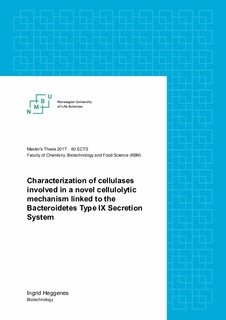| dc.description.abstract | Lignocellulose is the most abundant biomass on earth and has a great potential as a source for sustainable production of valuable chemicals and biofuels. Today’s depletion of fossil fuel reserves and pollution from their usage creates a need for a more sustainable source of energy. Lignocellulosic biomass is generally regarded as a sustainable and environmentally friendly energy source. However, the production of fuels from biomass is not sufficiently effective to compete fully with fossil fuels on economic terms, mostly due to the low efficiency of the enzymes needed to degrade the biomass. Thus, the need for better enzymes for the conversion of biomass to sugars and eventually biofuels is evident, and a better understanding of how biomass conversion occurs in nature may lead to improvements in the technology.
This thesis was based on a metagenomic study of a cow rumen microbiome sample enriched on switchgrass, where further investigation revealed a putative cellulolytic gene cluster, from a Bacteroidetes-affilated phylotype genome (AGa), with four putative cellulolytic glycoside hydrolase 5 (GH5) family enzymes. The cluster contained both multi-domain enzymes and enzymes with a C-terminal secretion tag for the Type IX secretion system (T9SS). The T9SS has been linked to cellulose degradation in Bacteroidetes. The aim of the present study was to clone, express and purify these GH5 enzymes for biochemical characterization to gain insight into their substrate targets and functional roles in the cluster.
The enzymes, together with truncated versions containing only one domain, were cloned, expressed and purified. Some of the enzymes gave inclusion bodies upon expression and had to be expressed with fusion tags. Further, the enzymes were characterized, through enzymatic assays, in terms of pH and temperature optima, temperature stabilities, substrate specificities, product profiles and cellodextrin cleaving patterns. Enzyme activity was analysed by the dinitrosalicylic acid (DNS) method, high-performance anion-exchange chromatography with pulsed amperometric detection (HPAEC-PAD) and high-performance liquid chromatography/mass spectrometry (HPLC-MS). Additionally, the binding to cellulose by a putative carbohydrate-binding domain (CBM) domain from one of the cellulases was investigated, and crystallization trials were executed on an interesting, potentially mutated GH5 domain. Finally, metaproteomics was performed on a cow rumen sample in an attempt to reveal the presence of the enzymes in vivo.
Characterization revealed cellulase activity on crystalline cellulose, filter paper, for almost all GH5 enzymes present in the cluster. The enzymes had optimal activity at pH 5.0-6.0 and temperature 50-60 ºC, and temperature stability up to 40 ºC on carboxymethyl cellulose (CMC). The enzymes were active on various substrates with β-1,4-glucosidic linkages in the backbone and on the lignocellulosic substrate switchgrass. Product analysis showed release of mostly cellobiose from cellulosic substrates, and cellodextrin assays showed cleaving of cellopentaose to cellobiose and cellotriose, and cellohexaose to cellobiose, cellotriose and partly cellotetraose for the majority of the enzymes. One GH5 displayed a different cleaving pattern on cellohexaose, cleaving it to solely cellotriose. Combining the enzymes in cocktails gave no synergistic effects. The weakly annotated CBM domain in one of the enzymes was shown to bind to the cellulosic substrate Avicel, indicating a correct annotation as a CBM. Crystallization efforts for one of the domains yielded no diffraction quality crystals and the metaproteomic investigation could not detect peptides specific for the AGa genome.
In conclusion, this thesis describes the characterisation of enzymes from a newly discovered cellulolytic gene cluster, revealing varying activities and substrate preferences, indicating that these enzymes have complementary roles in lignocellulose degradation. The cluster enzyme characterization gives insight into the use of the Type IX secreted multi-domain cellulases. Further work on the gene cluster can provide more insight into the degradation mechanism, and expression of the cluster in a bacterium harbouring the Type IX secretion system could be pursued to improve the expression of the multi-domain cellulases that were difficult to express. Ideally, the isolation of a representative of the AGa phylotype would shed light on its true involvement in cellulose degradation. Collectively, the work presented in this thesis contributes to the understanding of biomass degradation by anaerobic-bacteria, which can help improving the industrial conversion of biomass to valuable products in the future. | nb_NO |
| dc.description.abstract | Lignocellulose er den mest forekommende biomassen på jorden og har et stort potensiale som kilde til bærekraftig produksjon av verdifulle produkter som kjemikalier og biodrivstoff. Dagens uttømming av fossile brennstoffreserver og forurensning fra bruken av disse viser behovet for en mer bærekraftig kilde til energi. Lignocellulosisk biomasse blir sett på som en bærekraftig og miljøvennlig energikilde, men produksjonen av for eksempel biodrivstoff fra biomasse er ikke effektiv nok til å fullt ut kunne konkurrere med fossilt brennstoff på økonomiske vilkår, mest på grunn av lite effektive enzymer. Det er derfor et stort behov for bedre enzymer i omgjøringen av biomasse til sukker og tilslutt biodrivstoff, og en bedre forståelse av hvordan dette foregår i naturen kan føre til forbedringer i denne teknologien.
Denne oppgaven ble basert på en metagenomisk studie av en switchgrass prøve fra kumage, hvor videre undersøkelser fant et antatt cellulolytisk genkluster, fra en Bacteroidetes fylotypes genom (AGa), med fire antatt cellulolytiske glykosid-hydrolase familie 5 (GH5) enzymer. Klusteret inneholdt både multi-domene enzymer og enzymer med et C-terminalt sekresjonssignal for Type IX sekresjonssystemet (T9SS). T9SS har blitt koblet til cellulosenedbryting i Bacteroidetes. Målet med denne studien var å klone, uttrykke og rense disse GH5 enzymene for biokjemisk karakterisering for å få innsikt i deres målsubstrater og funksjonelle roller i genklusteret. | nb_NO |

